When you think of spearing fish you picture a person with an old pair of fins and a pole spear swimming around the shallows at your local beach. In the past 10 years the sport has come a very long way in the equipment used, the locations visited and in the species that are targeted.
Technology also plays a big part, as it does in line fishing. Areas all of us thought were too far or treacherous to reach in the past, are now seeing line fishers and spearfishers encroaching into new frontiers. We have been running spearing trips to the Coral Sea from Gladstone, Queensland, for over a decade and thought that a description of such a trip may interest all fishers.
This trip left in the beginning of October. Typically 20 people plan their trip 12 months prior, and we charter a very sea worthy vessel, the Eastern Voyager, for the massive 10-day excursion. The boat is extremely well fitted out, with air conditioned rooms, an entertainment area, library and plenty of space to sit down and discuss the day’s events while eating. She is 89’ long and very heavy. The weight and shape of the vessel makes travelling the 500 odd kilometres comfortable. The Eastern Voyager is equipped with five tinnies powered by 30hp motors and all are fitted with sounders and VHF handheld radios. The radios provide us with added safety and easy communication with the other dories, and generally reduce the mundane routines a boat boy endures while looking after his divers in the water.
Just like any type of trip the weather plays the most important role and it determines when and where we can venture to. Every year we always plan to head past the local reefs and islands, past the Swains and then way out into the Coral Sea. We have been to many systems such as Samaurez, Cato, Wreck, Bird and Frederick reefs, and this year the weather decided to turn it on with a minimum 25 knots and maximum 40 knots from all directions of the compass. So what do you do then?
You can imagine how difficult it is with four blokes in a tinnie with massive amounts of equipment trying to get to the exposed sides of the reefs to encounter as many pelagic fish as possible. And we are after pelagic fish! So the wind and weather forced us to spend the first five days within the protection of the Swain Reefs system. We moved each day closer to the eastern edge of the system which would give us the shortest trip for when the weather allowed us to leave.
Just like all fishers, we still wanted to bring home some table fish for the weeks after the trip. So spending time in the Swains provided us with that opportunity. Typically 3 of the 4 divers enter the water leaving 1 onboard to provide visual contact with the divers and any assistance that may be required. A diver needs the help of the boat boy to assist in removing the fish from the water as we do not like to leave fish hanging around for the men in grey suits to come and steal. So every time a fish is speared it is handed to the boat and stored. We rotate the divers every 30 minutes so that everyone has equal time in the water.
Be aware that spearing fish is not easy. We all hold our breath and dive down to where the fish reside. Some divers can reach 35m, but most are limited to around 10-20m. Swimming down to these depths takes time, and leaves the diver with a short period to aim and shoot the fish he chooses. It is more selective than line fishing, but boy does it take some effort to do it. A good diver may make 150 to 170 dives in 1 day on breathold only.
So what fish species did we target in the Swains, remembering the weather restricted us to the sheltered sides? Of course the favourite is coral trout, along with all the edible demersal species such as the emperor family, jobfish, Spanish mackerel, some cod species, giant trevally (and just like catching them on line, when they are speared they provide a mammoth fight) and generally most table fish. Bag and size limits are adhered to strictly, and tallies of fish species are kept every day so not to exceed any regulations. Believe it or not, spear fishers are always conscious of how they may be viewed by the general public and endeavour to make sure their efforts fall within all boundaries. We did manage to find a sensational dog tooth tuna spot on the edge of the Swains, and this species of fish is the prize for any spearo because of their tenacity to fight. Wherever there is dogtooth there are always sharks hanging around to try and steal your fish. Make no mistakes, we lost plenty of fish to sharks, just like you do when you line fish, the only difference is that we are in the water to witness the event! The biggest tuna speared in the Swains was around 40kg, but after a hard fight, the whalers moved in before we could get the fish to the surface. The visibility within the Swains is typically anywhere from 5m to 20m.
Equipment plays a major role in this sport. Each diver will be wearing a mask, snorkel, massive fins and socks, a 3mm 2 piece wetsuit, weight belt, two knives, and gloves. They also have attached to their belt a whistle and a surface marker buoy in case they are separated from their mates and the tinnie. Then their terminal gear consists of a big speargun of at least 1.3m, sometimes up to 1.6m.
While spearing within the Swains a 1.3m gun is attached to a float of approximately 35L via a floating line 20m long. And just like line fishing this gear is not cheap for this application. Around the eastern boarder of Australia, the gun lengths are generally much shorter, but most of the other gear remains the same. When we managed to move out to the Coral Sea we change some of this equipment. We move to a longer gun with up to four rubbers, that pull out a 10mm thick shaft. These guns can shoot up to 10m. And we then add another float and a 7m bungee to the rigline to add stopping power for when we shoot the bigger fish.
The journey from the Swains to Frederick Reef is another 13 hours or so overnight. The weather is still poor, but we have come to get used to it. Frederick is a very large reef system and provides spearfishers opportunity to get in to the water in most winds. The only wind that prevents the tinnies coming down off the main boat is the NW direction. There is no protection from that wind out there, and luckily while we were at this reef, we were able to get in every day.
Spearing out here is different and you may find our techniques insane. Each diver has all his gear as mentioned before, but in addition, we carry a vertical teaser/flasher that we can set at any depth we choose to dive to. We also berley hard, in very deep water that can be up to 2km deep. Of course we cannot dive that far but the objective is to bring the fish to us, and yes, unfortunately the sharks are always close behind. The visibility here can exceed 60m which makes it easy for the fish to see us. The problem we have with the water clarity is that the targets appear closer than they really are, and we need to be conscious of that fact. So when we think we are close, we say to ourselves to get closer. You can see by some of the photos how clear the water is.
On the first drift of the first day at Frederick 1 boat witnessed over 40 wahoo, but seeing them doesn’t mean that we could land them. One wahoo of about 18kg was brought on to the boat that morning, and when they are shot, they absolutely scream away pulling the floats and diver along in the water. The visibility played havoc with the fellas, and they had plenty of opportunity to land fish. Their excitement got the better of them. More wahoo were shot along with yellowfin tuna, dogtooth tuna, high finned amberjacks, rainbow runners, plenty of reef species, trout, coronation trout, trevally, and a monster 46kg GT. Jobfish are a favourite species sort after, as you need to berley them up off the bottom and get them so interested in the food that they don’t see you coming down. All this, despite the weather.
The whole Coral Sea experience is mind blowing, with the divers spending up to seven hours a day in the water. We do not spear everything that we see, but witness so many events words cannot describe. We see sea snakes swimming around the divers, massive rays cleaning up the bottom of the fish frames after cleaning, tiger sharks doing the same. We also witness caves that hold huge grouper, red bass, and oversized trout up to 20kg. Just to be there to see a system work the way it does is amazing and the memories are unforgettable.
On the last day, we came from very deep blue water onto an area approximately 60m deep that had silvertip whalers cruising along the bottom, and above them were huge dogtooth tuna and yellowfin. Above these fish were a large group of schooling hammerhead sharks of around 80 in total. You can only imagine the sight.
Only a few charter boats get out to these remote reefs during the year, mainly due to the weather but also because the reefs closer hold greater areas to fish for prime table species such as red emperor. Many of these species are not present on the wider reefs, but for a spearfisher, the dream to land a pelagic fish such as a sailfish, wahoo or dogtooth continues to draw them back year after year.
At the end of the last day we stowed all of our equipment and prepared for the 35-hour steam home, with finally good conditions!
Many thanks to the crew onboard the Eastern Voyager especially the deckies Budgie and Clayt. And thanks to the passengers that did not whinge once about the weather, and put in 100% every day, and in the end came home with plenty of fish and even more stories about the one that got away! –Words by Luke Downie. Photos by Daniel Montes
Reads: 6151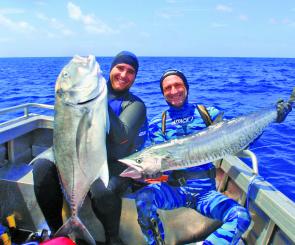
GT and mackerel out wide. These are two high priority spearfishing targets found around the Swains.
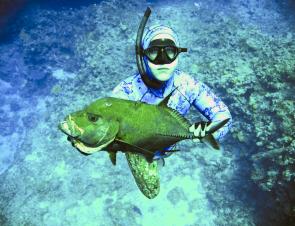
Spectacular visibility and a rewarding catch is why we go to all the effort to get out wide.
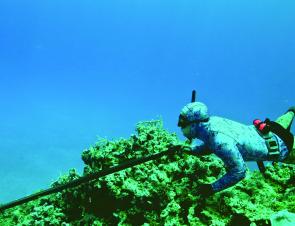
Waiting patiently is a trick many spearfishers need to learn and practice. The fish out wide can be surprisingly wary.
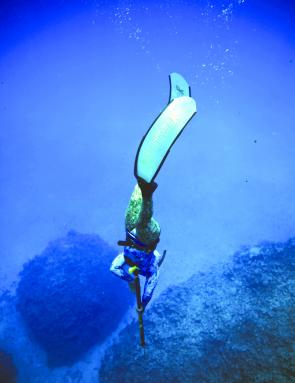
Big fins help to power divers down to the nooks and crannies where big coral trout and more hang out.
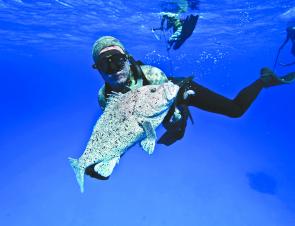
Good stuff. One more for the bag in an amazing location.
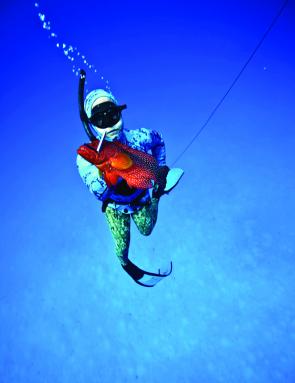
High on the target list, reef species make for sensational eating and can be chosen with the utmost care by the divers before a shot is fired.

Cruising home in idyllic conditions. Isn’t it always the way that the best of the weather is when you leave?




